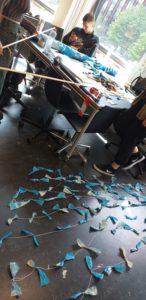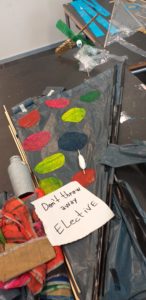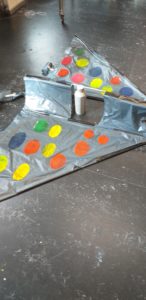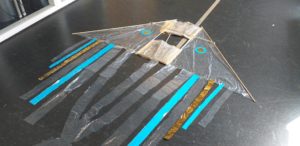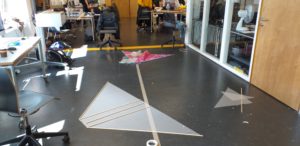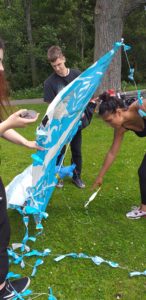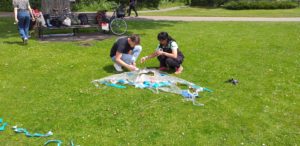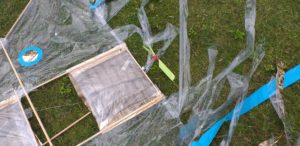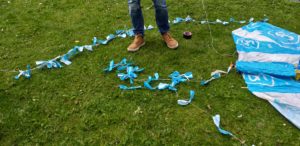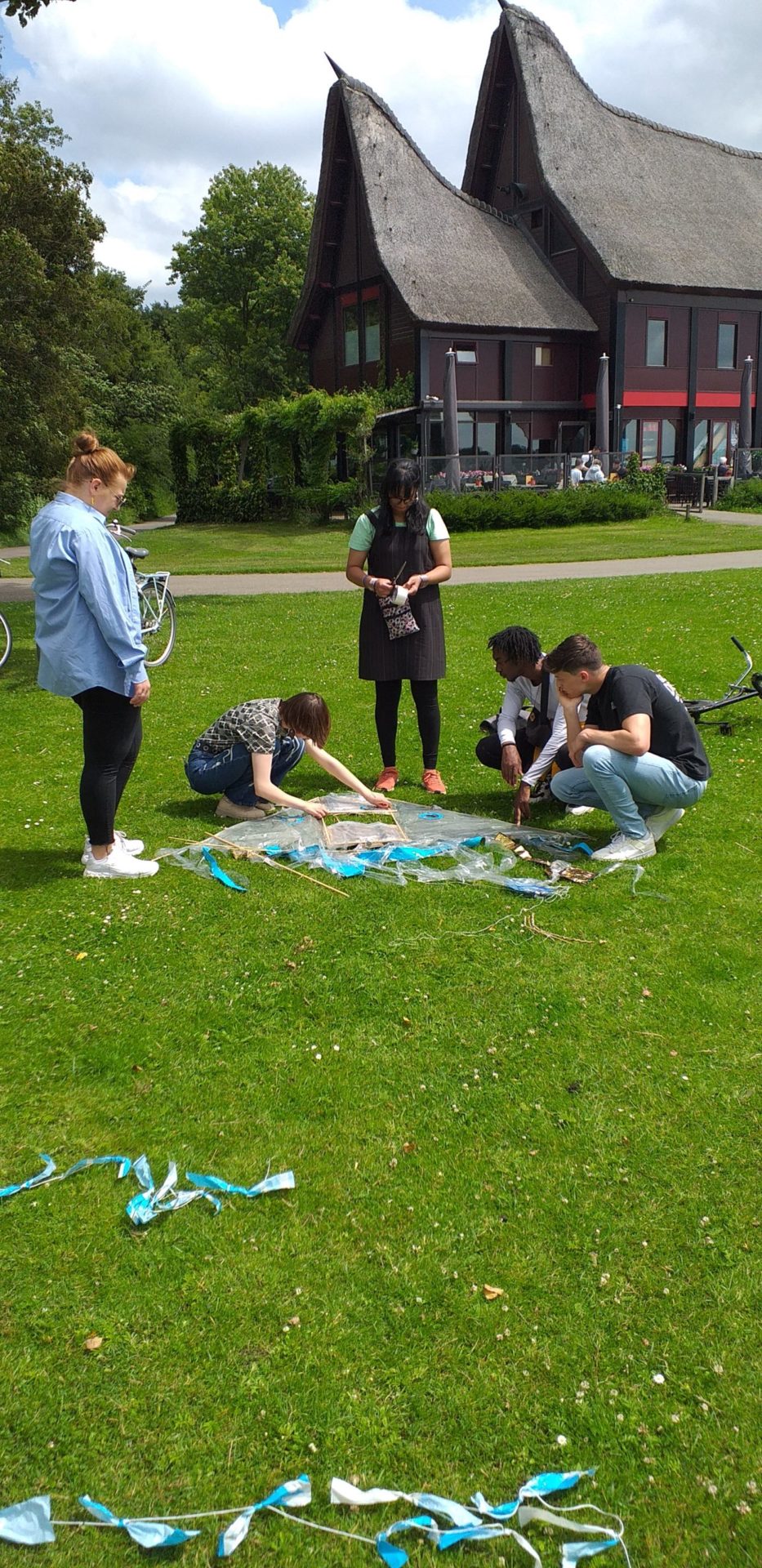- Learn from the Living Library
ENERGY FIELDLAB in action – Elective Kites & Energy
FIELDLAB – wind energy harvesting in combination with kite making
LAB: we dived into the idea of experiencing generating energy with kites by making kites, by making a simple electro-motor, by making a propeller from a pet bottle, by using an existing generator and adding this with the propeller to the kite.
We made first small kites, we flew these kites, by running in school, by using the wind outside the building – then in groups we made a bigger kite.
We did practice an electric circuit and even (briefly) looked at the use of microcontrollers for sensing, for steering.
We looked at existing far more advanced projects.
FIELD: We flew the kites, we had the propellor turning, made pictures and movies, we proved that the concept could work, even in this simple set-up.
We reflected on our experiences, and how we could apply this energy-kite experience to other fields or projects, like the Major.
In a logbook the students wrote what they did each days, and their experiences, feelings, making sketches, adding samples.
The educational model is experiential learning: start by doing (playing), getting your hands involved. Then look what works, what could be improved. Try again.
Some stages from the affective taxonomy could be traced: being present, responding, having enormous fun in flying the kite at the Kralingse Plas. The first tries to personalise the kite.
Emergency (from the description of the workshop by Beam)
Energy, we use it all the time. Just get it out of the wall, burn some petrol. But wait! Where does this energy come from? The Earth, the Sun…and do we give something back? No???? Just take and not give back – that means…problems!!! Energy scarcity, fighting for the last drop of energy. This elective will investigate a way not to steal energy from the Earth. We will harvest the energy from the wind, using designer ways: making. Designers can invent, build, test, reflect and improve.
We as designers will build a kite, we will build a dynamo. We need some electronic and a microcontroller, which we also learn on the way. Then we fly the kite with the energy device and show the World how to behave – like a responsible designer!
Detailed program and links:
Kites&energy
Contents
- 1 first elective day program – kite making session
- 2 second elective day program – electro motor and propeller session
- 3 Thursday – third elective day program – making a bigger delta kite
- 4 Friday – fourth elective day program – testing kite + electrometer system
- 5 Monday fifth elective day program – reflecting – improving
- 6 elective main learning goals
- 7 Pedagogical Model
- 8 making tools – machines
- 9 ways of kite making
- 10 special kite design challenge
- 11 kite materials
- 12 kite shop
- 13 kite theory
- 14 kite tails
- 15 propellor making
- 16 basic electronics
- 17 basic electronic components we will use
- 18 electro motors
- 19 microcontroller
- 20 ordering microcontrollers, electronics
- 21 electronics, Beam’s setup for a stepper motor
- 22 energy harvesting
- 23 elective pictures
- 24 design and inventor sites on kites and energy: “the real”
- 25 kite design
- 26 Beam’s kite projects
first elective day program – kite making session
welcome!
intro
Emergency!!!!! Energy is …
- a paradox So called taai vraagstuk (Dutch), or wicked problem
- there is so much
- it is not enough
- and what there is – climate change
- at least
- don’t waste – but what is wasting energy exactly?
- reuse existing energy – wind is energy
- reduce footprint -but again what is a footprint?
- address the paradox problem – become aware of its complexity
Concept of “The Living Station” https://livingstations.wdka.nl
- Energy as a substance for Design
experiential learning
this page: http://interactionstation.wdka.hro.nl/wiki/Kites%26energy
Elective picture page: https://www.flickr.com/photos/contrechoc/albums/72177720298378464
- tree seeds
- rotator toy
- making a micro delta
- a small zero waste kite: https://airlaboart.wordpress.com/2019/07/14/zero-waste-open-source-hackable-micro-kite-design/
- making tetra – AI file (for lasercutter) – http://www.contrechoc.com/2022/micro_tetrahedraal.ai (after downloading – if necessary, – delete .ps)
trying out kites by….wind….running…adjusting….making movies….documenting
lunch talk by Sandrine
making the Indian bana kite https://www.youtube.com/watch?v=u8cI7EN97oU
adjusting kite properties
intro microcontrollers
- making a drum machine
- theory: https://www.youtube.com/watch?v=tm2BgO1VaRY
- why? – sending morse code by the kite – this is a kind of pattern, like a drum beat
reflection on learning
showing and or flying some kites
second elective day program – electro motor and propeller session
start at 9:00
Sandrine: energy transformation – what is a motor –
- https://www.flickr.com/photos/contrechoc/45895540705/in/album-72177720298378464/
- https://www.flickr.com/photos/contrechoc/46761806491/in/album-72177720298378464/
- https://www.flickr.com/photos/contrechoc/52041951729/in/album-72177720298535246/
A “normal” motor works on a heat difference – steam engine, car motor.
Motors on wind or solar energy don’t use a heat difference. First there is electricity from somewhere, then with a clever trick of copper wiring, this is converted into movement. The clever trick uses the principle of induction.
let’s take a look at some “real” kite energy projects video’s
- https://www.youtube.com/watch?v=FQJ8rfoRyUQ
- https://youtu.be/vMTchVXedkk?t=110
- https://www.youtube.com/watch?v=FQJ8rfoRyUQ
- https://windswept-and-interesting.co.uk
- Kite power systems: https://www.youtube.com/watch?v=vMTchVXedkk
- 1 minute KiteKraft: https://www.youtube.com/watch?v=42jvQpgfm94
some intro electricity from magnets and spools
- induction Khan academy https://www.youtube.com/watch?v=Ylgb8FFMgd4
- brushless dc motor https://www.youtube.com/watch?v=bCEiOnuODac
demo special generator spool
making spool from copper wire https://www.youtube.com/watch?v=WI0pGk0MMhg and the funny rotator: https://www.youtube.com/watch?v=voHz6sxwQ2Q
study difference
- electro motor
- generator
- stepper motor
making propeller
checking with volt meter
kite theory
different kites
again microcontrollers
connecting to the microcontroller maybe?
reflection on learning
improving kite making
- color the kite surface
- put text on the kite surface
Thursday – third elective day program – making a bigger delta kite
in your group, you work on your project of kites and energy
there is a small generator available for your group.
one way to go is making a sort of delta kite (the one I showed you) and add your propeller
make a better propeller if necessary, or add all propellers….
find out and make a connection to the generator (making challenge)
show that the led is lighting up
if finished - test you propeller kite in the air this is for Friday
Friday – fourth elective day program – testing kite + electrometer system
morning – you finish your kites in school, so that we can all see what you did and already discuss it.
afternoon - flying the kites
kite ready?
energy system attached?
Location Kralingse Plas, depending on the wind direction, one of the four sides of this square lake.
hopefully there is enough wind – otherwise you have to run your kite
great site for wind prediction: wind finder.com – https://www.windfinder.com/#13/51.9352/4.5300/2022-06-10T12:00Z
doing making reflecting documenting
Monday fifth elective day program – reflecting – improving
Monday morning 10:00 – 12:30 we will start the last session.
Bring your bigger kite to school!
We will review the elective and find out what you learnt – also how your learning style.
We will look back at the program and make a general documentation using your best pictures, stories and thoughts
During your kite making don’t forget to make pictures.
At 12:00 or so I have to review your activities from the “logbook” where you made notes and decide if you have passed the elective or not – based on your activities.
showing chatting doing making reflecting documenting
what did we learn? More important: HOW did we learn, how did you learn, there are different styles....
elective main learning goals
making – on two levels
- design part: kite, shape but also dynamics – something that lifts of in the air
- design challenge or mission – generation of energy (solving the emergency) by using wind
making – styles
- improvised making
- being able to switch between materials and technology
- reflection on what you make – how to improve
making with uncertainty
- not being expert in either kite design or energy – how to deal with this?
- stay in your flow zone – yes, easier said than done 🙂
- you start with all kinds of unknown techniques, materials, concepts – coping strategies
- try out, make mistakes, fail and go on
- learning is only be done by making mistakes, so mistakes are not at all catastrophes, errors or stupid!!!!
- making mistakes: loss of time, money….yeah – that is learning – but then it is not wasting time!
- stress – yeah that is learning – try to keep yourself balanced
- this is psychology – yes of course 🙂
- if you see something beautiful, or somebody performing well …. be sure the person has put a lot of time and effort into it – and has suffered to get at this level.
- resist giving up
- reflect, take time for new approaches
- ask advice
- really practice sometimes, till you get it
- be on the look out for other ways, even other subjects
- remember your solutions, for other cases
making – reflections
- practical making
- critical making
- investigating making
different learning domains
- making
- working with materials
- working with tools and machines
- integrating technology
- electronics
- microcontrollers
- programming
- testing, going out and fly the kite
- check your goals
- what is the energy coming out
- did the kite fly well
- was it designer fun
- how can this be improved?
- what did I learn
- how will I try this differently the next time
Pedagogical Model
The model we use for this elective is experiential learning (D.A. Kolb, 1984: Experiential learning: experience as the source of learning and development, Englewood Cliffs, NJ: Prentice Hall)
There’s is even a model on top of this: of Kay Peterson and David A. Kolb, 2017 : “How you learn is How you live”: https://www.researchgate.net/publication/315449473_How_you_learn_is_how_you_live_Using_nine_ways_of_learning_to_transform_your_life
These models are within the so called affective domain – described or proposed by Bloom and Krathwohl – Handbook II. Affective domain – 1956 the text of which can be found here: https://archive.org/details/taxonomyofeducat0000bloo_o9o7
This affective domain is in contrast with the first domain of Bloom and Krathwohl – the cognitive domain.
We are at what I call “a school which operates mainly inside the affective domain”
Affective means here in school terms:
- learning be being there (in the school) with your fellow students
- by being present and actively engaged
- by forming opinions on what your learn
- by integrating, nurturing and developing these values inside your personality
- by being changed by what you learn
- thus learning could be called “subjective”
The affective domain is in contrast with, or next to the cognitive domain because in the cognitive domain you could learn by yourself, just by reading, in a very academic way, and the knowledge acquired is supposed to be objective.
There is a third domain: the psycho motor domain.
This is the “making” part of this elective in a way. You will become “skilled” that is you need to teach your hands, but also in running the kites, you need to learn how to move….
Of course, can we really separate ourselves into “cognitive”, rational, objective, and “affective”, subjective, and behaviour, movement? No! We are beings, and have it all at the same time.
But we like to make models, analyse, reflect don’t we?
making tools – machines
bigger machines:
- 3D printer
- lasercutter
- sewing machine
smaller tools:
- glue gun
- cutter
- fine saw
- scissors
- ruler
for electronics and microcontroller:
- soldering device
- volt meter
- different electronic tools
- programming environment and laptop
- programmer
ways of kite making
Prototyping: DIY, cheap, fast
- plastic bag – Indian: https://www.youtube.com/watch?v=64wI7OCne4A
- newspaper – Indian: https://www.youtube.com/watch?v=5lRzF5ZtrA8
- different kites Beam made and bought: https://airlaboart.wordpress.com/kites/
making a small tetrahedral kite from straws: http://mathandecon.councilforeconed.org/35/visuals/lesson7_activity.pdf
Professional
Then you need more expensive materials, good sewing skills, experience with kite making, ideas, kite passion
- carbon fibres or even more advanced
- spinnaker nylons or polyesters as fabrics
- sewing borders
- protecting fragile spots
- foldable, transportable
- very precise and sturdy 3D printed joints – or better
- unexpected, spectacular designs
- not my design: really great: https://www.flickr.com/photos/contrechoc/47702710001/in/album-72157707131754945/
- my design: not so great but … a nice start: https://www.flickr.com/photos/contrechoc/47702841731/in/album-72157707131754945/
please make 10 more before even be starting to be proud of yourself! This is really “a skill”.
and a lot of practice making
- i made the first box kite: https://www.flickr.com/photos/contrechoc/47461352752/in/album-72157707131754945/
- i made the second box kite: https://www.flickr.com/photos/contrechoc/40621416803/in/album-72157707131754945/
but you need to be very inspired for this one: (not my own) https://www.flickr.com/photos/contrechoc/40654374043/in/album-72157707131754945/
special kite design challenge
very practicable
a kite needs to be foldable!
the door and the kite problem: https://www.flickr.com/photos/contrechoc/48670548301/in/album-72157707131754945/
https://www.flickr.com/photos/contrechoc/51236538009/in/photostream/
for this elective I propose the delta , which is foldable: https://www.flickr.com/photos/contrechoc/47906437801/in/album-72157707131754945/
self made delta in flight: https://www.flickr.com/photos/contrechoc/47985659773/in/album-72157707131754945/
bought delta in flight (video): https://www.flickr.com/photos/contrechoc/47277639981/in/album-72157707131754945/
kite materials
cheap DIY
- newspaper paper
- plastic from bags etc
- any light weight paper or material
- BBQ sticks!
- bamboo
Special material
- kite paper
- Tyvek paper https://www.depaddestoel.nl/Tyvek-per-Meter
- polyesther https://www.depaddestoel.nl/Spinnaker-Polyester-Dik
- carbon fiber
- wooden sticks
kite shop
in the neighbourhood (Schiedam) https://www.depaddestoel.nl – can also order online here
online: bv https://www.devliegerwinkel.nl/nl/
also amazon.nl and bol.com
kite theory
nasa site: https://www.grc.nasa.gov/www/k-12/airplane/kite1.html
kite tails
rotating tails, bought from shop (Beams kite) : https://www.flickr.com/photos/contrechoc/52028850994/in/album-72177720298378464/
propellor making
we will start “propellers” folding rotating thing: https://www.youtube.com/watch?v=6MJ2eDFSklA
different shapes: https://www.flickr.com/photos/contrechoc/52121329996/in/dateposted/
material: pet bottle plastic and sheet metal from tins
Beam’s example: https://www.flickr.com/photos/contrechoc/52121329996/in/dateposted/
from metal cans: don’t cut your fingers and hand: https://www.youtube.com/watch?v=WEQnYfp1THM
3D printing: https://www.flickr.com/photos/contrechoc/52111439912/in/album-72177720298378464/
Thingiverse: https://www.thingiverse.com/thing:173994
Other kinds of small wind turbines:
basic electronics
what is V – Volt – symbol V
what is Ampere – current – symbol I
what is resistance – symbol R
Law of Ohm connect V and I and R: V = I times R – this seems simple but can get complicated when several circuits are combined.
what is a circuit?
basic electronic components we will use
electonic components is series
electronic components in parallel
battery – producer of energy has a voltage
wire – is conductive – connects components
resistor – any component has a resistance and gives a drop in voltage
diode – something that lets current through or not depending on the direction – also has a voltage drop – LED
speaker – transfers energy into sound
electromotor – either makes rotation – movement – from voltage and current (electric energy) or makes electricity from rotation (as a generator)
advanced
voltage regulator – prevents voltage above a certain boundary, for instance 5V
rectifier – makes DC current from Alternating current
electro motors
typically designerish: exploring into a very specialised field … as naive as a baby….:-)
a bit clumsy: https://www.youtube.com/watch?v=WI0pGk0MMhg
see Beam’s experiment: https://www.flickr.com/photos/contrechoc/52112947630/in/album-72177720298378464/
and try this one:
Making smallest DIY dynamo motor: https://www.youtube.com/watch?v=nCplwikusyw
Advanced explaining and using a stepper motor:
Making generator from stepper motor: (using h-bridge, capacitor)
- https://www.youtube.com/watch?v=twtgBgkBZPI
- https://www.youtube.com/watch?v=-zCTggoh994
- https://www.youtube.com/watch?v=lAvCYuNxGS8
mini wind turbine: https://www.youtube.com/watch?v=938dTRrwrYc (a test if it is worth the trouble of printing)
(well commercially …. but for “learning”!!!!)
this is the turbine he is talking about: https://www.amazon.nl/TEX-Energy-Infinite-Ausgangsstrom-Micro-USB/dp/B075RF17NV/ref=sr_1_1?__mk_nl_NL=ÅMÅŽÕÑ&crid=1064Q9X69FI5I&keywords=Infinite+Air&qid=1654454500&sprefix=infinite+air%2Caps%2C158&sr=8-1
pretty big for our kites….
why not using these bigger motors???
advanced: electrometers are … complicated…https://www.youtube.com/watch?v=AdNVg1MWc8c
see also the links in the description of this video
so here we conclude … yeah, but is is very speculative….
microcontroller
a microcontroller can be programmed to open or close circuits
we will use this to try to send morse code from the kite
needs energy, which comes from the electrometer which is rotated by the wind
script for Attiny85 on kite: https://github.com/contrechoc/watchdog_for_kite/tree/main
For this elective – microcontrollers:
- Arduino – for intro – school Arduino https://www.arduino.cc
programmable as Arduino, but smaller and lighter:
- ATtiny85: https://nl.farnell.com/microchip/attiny85v-10pu/mcu-8bit-attiny-10mhz-dip-8/dp/1455165?st=attiny85
programmable as Arduino, but smaller and lighter: (needs a programmer)
ordering microcontrollers, electronics
I order online
webshops which deliver fast: (in the Netherlands)
specially for electronics
electronics, Beam’s setup for a stepper motor
https://www.flickr.com/photos/contrechoc/52112974355/in/album-72177720298378464/
https://www.flickr.com/photos/contrechoc/52111439912/in/album-72177720298378464/
using a rectifier because of alternating current, then a voltage regulator: https://www.flickr.com/photos/contrechoc/52117231590/in/dateposted/
using a script with a “watch dog timer” in the ATtiny85
the IKEA LJUSA shows how the rectifying circuit should be done in a “real energy harvesting device”: https://www.flickr.com/photos/contrechoc/52126074143/in/photostream/
energy harvesting
collecting small amounts of energy and transfer this into electricity
- movement, vibration
- temperature differences
- solar energy
- radiation energy, for example WFI
- plant energy, like algae, or bacteria around roots of plants
what is “small”?
what to do with small amounts of energy?
- collect data, like temperature, pollution
- send data to a bigger device
very small devices, small batteries, specialised chips, for example LTC
very small energies: not something that charges your smartphone.
an old blog of Beam: https://energyharvestingresearch.wordpress.com/author/contrechoc/ e-textile summercamp workshop: http://etextile-summercamp.org/2014/capacitor-energy-harvesting/ Beam interaction station page: http://interactionstation.wdka.hro.nl/wiki/Research/Research2014-2015-Beam#Research:_Design_and_Energy_Harvesting
applied in this elective: generate energy for sending a morse code for a LED
elective pictures
Beam’s picture collection on Kites&energy: https://www.flickr.com/photos/contrechoc/albums/72177720298378464
design and inventor sites on kites and energy: “the real”
Scottisch inventor:
Kite power systems: https://www.youtube.com/watch?v=vMTchVXedkk
KiteKraft: https://www.youtube.com/watch?v=42jvQpgfm94
Florian Bauer – kiteKraft blog: https://medium.com/@florian.bauer
kite design
Kite building archive: https://www.kiteplans.org
Kites-101: https://sites.google.com/site/kites4all/kite-101
Beam’s kite projects
Beam’s kite project in France: https://airlaboart.wordpress.com
Beam collaboration with Hans Was – poet – project “Woorden in de Wind”: https://www.youtube.com/watch?v=mDw3T5K2qls
and this elective!
